
The St. Louis Eagles were a professional ice hockey team that played in the National Hockey League (NHL). Based in St. Louis, the Eagles played for only one year, the 1934–35 NHL season.
The National Hockey Association (NHA), initially the National Hockey Association of Canada Limited, was a professional ice hockey organization with teams in Ontario and Quebec, Canada. It is the direct predecessor of today's National Hockey League (NHL), and much of the business processes of the NHL today are based on the NHA. Founded in 1909 by Ambrose O'Brien, the NHA introduced 'six-man hockey' by removing the 'rover' position in 1911. During its lifetime, the league coped with competition for players with the rival Pacific Coast Hockey Association (PCHA), the enlistment of players for World War I and disagreements between owners. The disagreements between owners came to a head in 1917, when the NHA suspended operations in order to get rid of an unwanted owner, Eddie Livingstone.
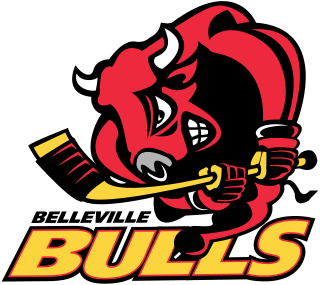
The Belleville Bulls were a junior ice hockey team, founded in 1981 and based in Belleville, Ontario. The team played in the Eastern Division of the Eastern Conference of the Ontario Hockey League (OHL). The team relocated to Hamilton, Ontario, at the end of the 2014–15 OHL season.
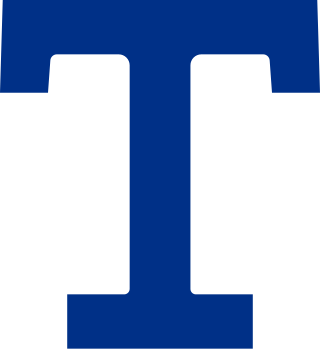
The Toronto Hockey Club, known as the Torontos and the Toronto Blueshirts, were a professional ice hockey team based in Toronto. They were a member of the National Hockey Association (NHA). The club was founded in 1911 and began operations in 1912. The club won its sole Stanley Cup championship in 1914.
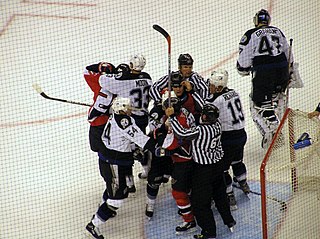
Violence has been a part of ice hockey since at least the early 1900s. According to the book Hockey: A People's History, in 1904 alone, four players were killed during hockey games from the frequent brawls and violent stickwork.

Stittsville is a suburban community, part of the Canadian capital of Ottawa, Ontario. It is within the former Goulbourn Township. A part of the National Capital Region, Stittsville is immediately to the southwest of Kanata, adjacent to Richmond and about 20 km (12 mi) west of Downtown Ottawa. The urban part of the community corresponds to Stittsville Ward on Ottawa City Council and has been represented by Glen Gower since 2018. As of 2021, Stittsville ward had a population of 40,889.
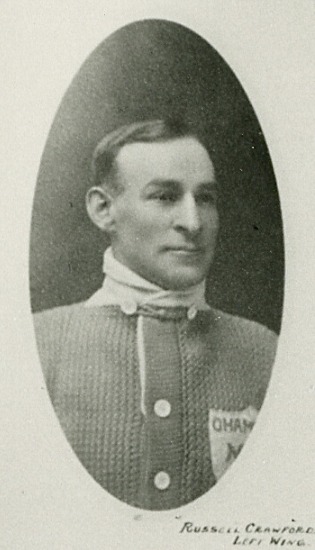
Samuel Russell Crawford was a Canadian professional ice hockey forward who played for the Quebec Bulldogs of the National Hockey Association (NHA), Ottawa Senators and Toronto Arenas of the National Hockey League (NHL) and Saskatoon Crescents, Calgary Tigers and Vancouver Maroons of the Western Canada Hockey League (WCHL). He was a two-time Stanley Cup champion, winning the trophy with the Bulldogs in 1913 and the Arenas in 1918. Crawford was one of the sport's early stars and appeared in 258 games in the three major leagues, scoring 110 goals. He was inducted into the Hockey Hall of Fame in 1963.

Harold Macarius Hyland was a Canadian professional ice hockey forward who played for the Montreal Wanderers, New Westminster Royals, and Ottawa Senators. He was a star in the early years of professional hockey. Hyland played in the inaugural 1917–18 NHL season, where he and Joe Malone scored five goals on the NHL's first day of play on December 19, 1917, setting three NHL rookie records that remain unbroken since.
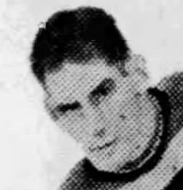
John Allan Shields was a Canadian professional ice hockey defenceman who played eleven seasons in the National Hockey League for the Ottawa Senators, Philadelphia Quakers, New York Americans, Montreal Maroons and Boston Bruins between 1927 and 1938.
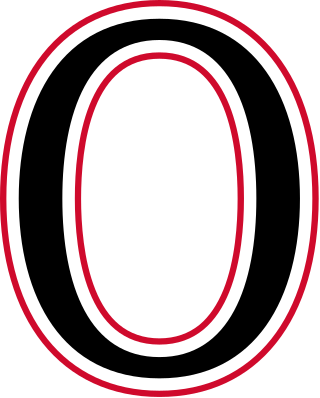
The Ottawa Senators were an ice hockey team based in Ottawa, which existed from 1883 to 1954. The club was the first hockey club in Ontario, a founding member of the National Hockey League (NHL) and played in the NHL from 1917 until 1934. The club, which was officially the Ottawa Hockey Club, was known by several nicknames, including the Generals in the 1890s, the Silver Seven from 1903 to 1907 and the Senators dating from 1908.

Euclid Beach Park was an amusement park located on the southern shore of Lake Erie in the Collinwood neighborhood of Cleveland, Ohio, which operated from 1895 to 1969.
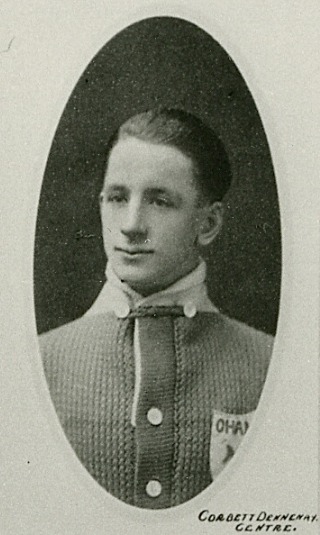
Charles Corbett "Corb" Denneny was a Canadian professional ice hockey forward who played professionally from 1912 to 1931, including nine seasons in the National Hockey League (NHL) for the Toronto Arenas, Toronto St. Pats, Hamilton Tigers and Chicago Black Hawks. Corbett also played for the Vancouver Maroons of the Pacific Coast Hockey Association (PCHA) and the Saskatoon Sheiks of Western Canada Hockey League. He twice won the Stanley Cup with the original versions of the NHL's Toronto franchise.
The Toronto Ontarios were a professional men's ice hockey team in the National Hockey Association from 1912 to 1915 based in Toronto, Ontario, Canada. They were first named the Tecumseh Hockey Club, renamed the Ontarios in 1913 and renamed the Toronto Shamrocks in January 1915 and ceased operations later that year.

The 1914–15 NHA season was the sixth season of the National Hockey Association and played from December 26, 1914, until March 3, 1915. Each team played 20 games. The Ottawa Senators won the NHA championship in a two-game, total goal playoff against the Montreal Wanderers. The Senators, however fell to the Vancouver Millionaires of the Pacific Coast Hockey Association in the Stanley Cup championship. It was the second 'World's Series' between the NHA and the PCHA for the Stanley Cup.

Francis James "Coddy" Winters was an American ice hockey player from Duluth, Minnesota. Winters, a defenseman, played ice hockey mostly in the Cleveland, Ohio area, including with the Cleveland Indians in the USAHA. In 1920–21 Winters won the USAHA championship with the Cleveland Indians.

Edgar Ernest Dey was an early amateur and professional ice hockey player and an athlete in canoeing. A member of the Dey family of Ottawa, known for canoe building, athletics and arena operation, he died in 1912 from an injury while playing hockey. He was a canoeing champion of Canada. His father, Frank Edgar Dey, was a co-owner of the Dey boat-building and Dey's Arena businesses in Ottawa.

Francis Roy "Minnie" McGiffin, last name sometimes spelt McGiffen, was a Canadian professional ice hockey player. He played for the Toronto Blueshirts of the Canadian National Hockey Association (NHA) from 1912 to 1915. He was a member of the 1914 Stanley Cup championship Blueshirts team.

The Maple Leafs–Red Wings rivalry is a National Hockey League (NHL) rivalry between the Toronto Maple Leafs and the Detroit Red Wings. The rivalry is largely bolstered because of the proximity between the two teams, with Toronto and Detroit approximately 370 kilometres (230 mi) apart, connected by Ontario Highway 401, and a number of shared fans in between the two cities. The teams both compete in the Atlantic Division and with current NHL scheduling, they meet three or four times per season.

The Cleveland Athletic Club ice hockey team was an amateur ice hockey team from Cleveland, Ohio operating during the first three decades of the 20th century out of the Cleveland Athletic Club. When the team joined the United States Amateur Hockey Association for the 1920–21 season it was known as the Cleveland Indians or Cleveland Hockey Club, and in 1924–25 as the Cleveland Blues.
The Boston Athletic Association ice hockey team was an American amateur ice hockey team sponsored by the Boston Athletic Association that played in the American Amateur Hockey League, United States Amateur Hockey Association, and Eastern Amateur Hockey League. The team won the AAHL title in 1916 and 1917 and the USAHA championship in 1923, and the EAHL title in 1926. The team was nicknamed the Unicorn after the association's symbol.



















